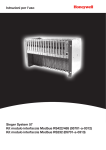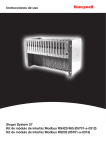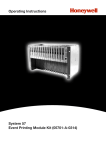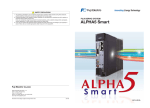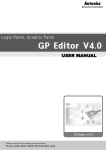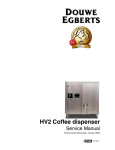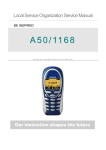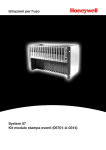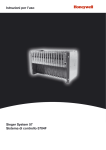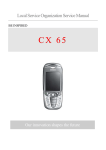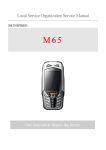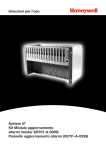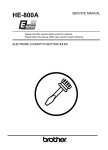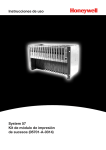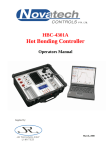Download System 57 Modbus Interface Module Kit Operating
Transcript
Operating Instructions Sieger System 57 Modbus Interface Module Kit RS422/485 (05701-A-0312) Modbus Interface Module Kit RS232 (05701-A-0313) MAN0502.PM6 Issue 04 Oct 99 05701M5006 MODBUS Interface Module Helping to make a safer world Ensure that you read and understand these instructions BEFORE operating the equipment. Please pay particular attention to the Safety Warnings. WARNINGS The items of equipment covered by this manual are: 1. Not designed or certified for use in hazardous areas. 2. Designed for indoor use only. 3. Not to be exposed to rain or moisture. CAUTIONS 1. Use only approved parts and accessories with the System 57 Control System. 2. To maintain safety standards, regular maintenance, calibration and operation of the System 57 Control System by qualified personnel is essential. IMPORTANT NOTICES 1. Zellweger Analytics Limited can take no responsibility for installation and/or use of its equipment if this is not done in accordance with the appropriate issue and/or amendment of the manual. 2. The user of this manual should ensure that it is appropriate in all details to the exact equipment to be installed and/or operated. If in doubt, the user should contact Zellweger Analytics Limited for advice. Zellweger Analytics Limited reserve the right to change or revise the information supplied in this document without notice and without obligation to notify any person or organisation of such revision or change. If further details are required which do not appear in this manual, contact Zellweger Analytics Limited or one of their agents. 2 MAN0502.PM6 Issue 04 Oct 99 05701M5006 MODBUS Interface Module GLOSSARY A1 A2 A3 LED * LTEL RFI RH * STEL * TWA * - Lower or Pre-warning Alarm Level. Second Pre-warning Alarm Level. Upper or Main Warning Level. Light Emitting Diode. Long Term Exposure Limit (8 hours TWA value). Radio Frequency Interference Relative Humidity. Short Term Exposure Limit (10 minutes TWA value). Time Weighted Average. Refer to the appropriate National Standards Authority for details. In the UK this detail is in the Guidance Note EH 40/89 from the Health and Safety Executive on Occupational Exposure Limits 1989. HELP US TO HELP YOU Every effort has been made to ensure the accuracy in the contents of our documents, however, Zellweger Analytics Limited can assume no responsibility for any errors or omissions in our documents or their consequences. Zellweger Analytics Limited would greatly appreciate being informed of any errors or omissions that may be found in our documents. To this end we include the following form for you to photocopy, complete and return to us so that we may take the appropriate action. 3 MAN0502.PM6 Issue 04 Oct 99 05701M5006 MODBUS Interface Module HELP US TO HELP YOU To: Marketing Communications, Zellweger Analytics Limited, Hatch Pond House, 4 Stinsford Road, Nuffield Estate, POOLE. Dorset. BH17 0RZ. United Kingdom. From: Address: Tel : +44 (0) 1202 676161 Fax : +44 (0) 1202 678011 email : [email protected] Tel : Fax : email : I suggest the following corrections/changes be made to Section ........... Marked up copies attached (as appropriate): Yes / No Please inform me of the outcome of this change: Yes / No For Marketing Communications, Zellweger Analytics Limited: Actioned By: Date: Response: Date: 4 MAN0502.PM6 Issue 04 Oct 99 05701M5006 MODBUS Interface Module CONTENTS Section Page GLOSSARY 3 1. INTRODUCTION 1.1 1.2 1.3 7 Principal Features Commonly Used Terms Construction 2. CONTROLS AND FACILITIES 2.1 2.2 2.3 Introduction MODBUS Interface Module - RS485/422 MODBUS Interface Module - RS232 3. INSTALLATION INSTRUCTIONS 3.1 3.2 3.3 3.4 3.5 Introduction Unpacking Installing the MODBUS Interface Kit Field Connections for RS485/422 Interface Field Connections for RS232 Interface 4. CONFIGURING THE MODBUS FUNCTION 4.1 4.2 4.3 General Host Computer Configuration System 57 Configuration 5. COMMISSIONING AND MAINTENANCE INSTRUCTION 5.1 5.2 5.3 Start Up Procedure Maintenance Fault Finding 7 8 9 13 13 14 17 18 18 18 19 21 29 33 33 33 33 36 36 36 37 6. OPERATING INSTRUCTIONS 38 7. MODBUS FUNCTION REFERENCE 39 7.1 7.2 7.3 7.4 7.5 7.6 7.7 7.8 7.9 Introduction Card Slot Number and Sub-channel Designation Function 02 - Read Input Status Function 04 - Read Input Registers Functions 6 and 16 - Preset Single / Multiple Holding Registers respectively Function 3 - Read Holding Registers Exception Responses Query Poll Definitions Command Poll Definitions 5 39 40 40 44 46 49 49 50 54 MAN0502.PM6 Issue 04 Oct 99 05701M5006 MODBUS Interface Module CONTENTS 8. SPECIFICATION 8.1 8.2 8.3 8.4 8.5 8.6 56 Environmental EMC/RFI Conformity Serial Communication MODBUS Protocol RS485/422 Interface Module RS232 Module 56 56 56 56 56 57 FIGURES Figure 1. 2. 3. 4. 5. 6. 7. 8. 9. 10. 11. 12. 13. 14. 15. Page MODBUS Interface Module RS485/422 MODBUS Interface Module RS232 MODBUS Overview System Diagram for RS485 Connection. System Diagram for RS422 Connection System Diagram for RS232 Connection. SYSTEM 57- Engineering Card Mark II Front Access Connections for DC Input Card and MODBUS RS485/422 Option Module Rear Access Connections for DC Input Card and MODBUS RS485/422 Option Module Wiring Example Showing Multi-drop Dual Highway RS485 Connections, Termination Resistors, Host, Nodes etc. Wiring Example Showing Multi-drop RS422 Connections, Termination Resistors, Host, Nodes, etc. Front Access Connections for DC Input Card and MODBUS RS232 Option Module Rear Access Connections for DC Input Card and MODBUS RS232 Option Module Wiring Example Showing RS232 Connections Common Personal Computer RS232 Connector Pinouts 6 10 11 12 15 16 17 21 22 23 27 28 29 30 32 32 MAN0502.PM6 Issue 04 Oct 99 05701M5006 MODBUS Interface Module 1. INTRODUCTION 1.1 PRINCIPAL FEATURES The System 57 MODBUS Interface provides a facility for digital communication between the System 57 Control System and an external computer system. MODBUS is a well supported digital data communication protocol which provides a set of standard commands by which system data can be communicated. Two different interface modules are available to support the most widely used electrical interface standards, thereby ensuring compatibility with most external systems. Using the MODBUS Interface it is possible to read configuration, alarm status and other information from any channel in the rack and to perform calibration and other procedures. The MODBUS Interface is commonly used to connect the System 57 Control System to plant control systems to provide central monitoring of system status often with graphical display. The principal features of the MODBUS Interface are: Easily fitted to the Engineering Card. Compatible with 5701, 5704 and 5704F Control Cards. Simple field connections, via the DC Input Card terminal block, for wire up to 2.5mm² (14 AWG). Operates as a MODBUS RTU. Supports functions 02, 03, 04, 06 and 16 of the MODBUS protocol. Provides sensor gas readings and alarm status for Fault, Inhibit, A1, A2, A3, FIRE, STEL, LTEL and Rate alarms from all channels in the rack. Supports commands to Inhibit, Reset, Normalise (zero), Calibrate (span) and set Alarm Levels for all channels in the rack. Supports RS485, RS422 and RS232 electrical standards. Data signals isolated from System 57 power supply. Asynchronous serial link configurable for baud rate, parity and stop bits. Primary and secondary channel operation. Half duplex operation. Multi-drop capability. Easily configured using Engineering Interface Software. 7 MAN0502.PM6 Issue 04 Oct 99 05701M5006 MODBUS Interface Module 1. INTRODUCTION 1.2 COMMONLY USED TERMS The reader should be familiar with the following terms that are used throughout this instruction manual: MODBUS: Modbus is a digital data communication protocol which provides a widely used set of standard commands by which system data can be communicated to an external device. RS485: RS485 is an electrical standard that uses a twisted pair cable carrying differential signals to transfer digital data. RS485 permits up to 32 transceiver nodes to be connected onto a single twisted pair highway for 'multidrop' bi-directional operation over distances up to 1.2km (3900ft). RS422: RS422 is an electrical standard that uses a twisted pair cable carrying differential signals to transfer digital data. RS422 permits a single driver and up to 10 receiver nodes to be connected onto the highway for operation over distances up to 1.2km (3900ft). RS232: RS232 is an electrical standard that uses multi-core cable carrying signals to transfer digital data. RS232 permits interconnection of two communicating devices for bi-directional operation over distances up to 15m (49ft). Baud Rate: Baud is a unit of signalling speed equal to the number of discrete signal events per second. (Not necessarily the same as bits per second). Bit Rate: The speed at which bits are transmitted, usually measured in bits per second (bits/s). Parity: A technique used to detect single bit errors in a transmitted data byte (character) in electronic code transmission. Stop Bit: A method to indicate the end of a transmitted data byte (character) in electronic code transmission. Full Duplex: Refers to a communication system capable of simultaneous two way independent transmission of data. Half Duplex: Refers to a communication system capable of transmission of data in either direction, but not simultaneously. 8 MAN0502.PM6 Issue 04 Oct 99 05701M5006 MODBUS Interface Module 1. INTRODUCTION Simplex: Refers to a communication system capable of transmission of data in a single direction only. Multi-drop: A single communication line which is shared by a number of devices or 'nodes'. Node: An intelligent device present within a data communication system which is able to communicate. Host: The host system is a master device that controls the system operation. Typically a host will be either a PLC, DCS or SCADA Graphics package. Master: A master device is a node which controls transmission of data in a communicating system by issuing requests to slave devices. Slave: A slave device will only transmit data onto the communication line in response to a request from a master device. 1.3 CONSTRUCTION The System 57 MODBUS Interface is available pre-installed in new systems or as a kit for retro-fitting into existing systems. Two kits are available, one supporting the RS485 and RS422 electrical standards and the other the RS232 electrical standard. Each kit consists of: a. A small pcb MODBUS interface module that plugs onto the Engineering Card J1 and J2 connectors. b. Two integrated circuits that plug into the expansion sockets provided on the Engineering Card. Connections for the serial data interface are made via the six way expansion terminal block TB2 that is located on the DC Input Card. An enhanced version of the Engineering Card software must be installed in order to provide the MODBUS Interface functions. The new software, which is fully compatible with the original Engineering Card software, is provided as a plug-in integrated circuit included in the kit. 9 MAN0502.PM6 Issue 04 Oct 99 05701M5006 MODBUS Interface Module 1. INTRODUCTION LK1 and LK2 Settings 3 2 1 3 2 1 Terminated Unterminated Termination Link Channel 2 Termination Link Channel 1 Figure 1 MODBUS Interface Module RS485/422 10 MAN0502.PM6 Issue 04 Oct 99 05701M5006 MODBUS Interface Module 1. INTRODUCTION Figure 2 MODBUS Interface Module RS232 11 MAN0502.PM6 Issue 04 Oct 99 05701M5006 MODBUS Interface Module 1. INTRODUCTION Front Access 8 or 16-Way Rack Engineering Card Mk ll DC Input Card MODBUS Interface Module Rear Access 8 or 16-Way Rack Figure 3 MODBUS Overview 12 MAN0502.PM6 Issue 04 Oct 99 05701M5006 MODBUS Interface Module 2. CONTROLS AND FACILITIES 2.1 INTRODUCTION The 5701 and 5704 control systems provide a complete solution for the operational and engineering requirements of a multi-channel fire and gas detection system. Each control card within the rack system provides sensor drive, signal acquisition, gas concentration display and comprehensive alarm facilities for one or more fire or gas sensors. The MODBUS Interface facility extends the capability of the control system by providing an external computer system with monitoring and control functions for every gas sensor or fire detector connected to the rack. The operation and alarm integrity of the System 57 is not affected by the MODBUS Interface. The digital data link uses a bi-directional 8-bit asynchronous serial connection that is configurable for baud rate, parity and stop bits. Two different modules are available, one supports both RS485 and RS422 electrical interface standards and the other supports the RS232 electrical interface standard. Depending upon the module type, system configuration and the capability of the host computer, various communication options are available as follows: Interface Mode Transmission Option Dual Highway Option Multi-drop RS485 RS422 RS232 Half Duplex Half Duplex Half Duplex Yes No No Yes (31 Nodes) Yes (10 Nodes) No The dual highway option provides a secondary or backup data link for increased communication integrity. Multi-drop configurations allow a single communication line to be shared by a number of devices reducing the number of communication ports required at the host computer. RS232 provides the lowest cost solution for connecting a single System 57 rack to a host computer. RS485 provides the best solution for multi-drop connection of more than one System 57 rack to a host computer and also gives the option of a secondary highway. RS422 is useful to provide multi-drop connection where the host computer software does not have the facility for transceiver direction control (transmit/receive/high impedance) that is required with RS485 connections. 13 MAN0502.PM6 Issue 04 Oct 99 05701M5006 MODBUS Interface Module 2. CONTROLS AND FACILITIES In all cases the System 57 operates as a MODBUS Remote Terminal Unit (RTU), acting as a slave device node and transmitting data onto the communication line only in response to a request from a master device. The host computer system, typically a PLC, DCS or SCADA graphics package, acts as the master device controlling the communication system operation. The subset of MODBUS functions supported by the System 57 RTU are 02, 03, 04, 06 and 16. The MODBUS broadcast commands are not supported and will be ignored, however, global commands are available to reset all cards in the rack simultaneously. For a detailed description of the available commands and data formats refer to the System 57 MODBUS Function Reference given in Section 7. 2.2 MODBUS INTERFACE MODULE - RS485/422 2.2.1 General The RS485/422 Interface Module has two differential 5V transceivers designated channel 1 and channel 2. Each transceiver channel can be resistively terminated by setting LK1 and LK2 respectively (see Figure 1 and Section 3.4.3). The interface signals are isolated from the System 57 power supply 0V and Ground to protect the host computer against damage due to earth loops. 2.2.2 RS485 Operation An outline RS485 connection diagram is shown in Figure 4. When configured for the RS485 mode, transceiver Channel 1 is used in dual highway systems for the primary highway or the only highway in single highway systems. Transceiver Channel 2 is used only in dual highway systems where it functions as the secondary highway. Depending upon the type of installation, operation is possible over distances up to 1.2km (3900ft). In the multi-drop mode up to 32 nodes, including the host, can be connected. The terminal connections are: CH1-A, CH1-B Differential Transceiver Channel 1 (Primary). CH2-A, CH2-B Differential Transceiver Channel 2 (Secondary). DGND Isolated Data Ground. In a dual highway system the MODBUS uses, at any one time, only one of the two available highways, either the primary or the secondary. The interface automatically switches between highways when a communication failure is detected. 14 MAN0502.PM6 Issue 04 Oct 99 05701M5006 MODBUS Interface Module 2. CONTROLS AND FACILITIES RS485 Master Rx/Tx RT Rx/Tx Primary Highway Optional Secondary Highway RT System 57 Node 1 System 57 Node 2 RT Termination resistors fitted to host and last node only. The System 57 RS485 module bus termination resistors are link selectable. See Figure 1 and Section 3.4.3. System 57 Node 3 RT System 57 Node 32 RT Figure 4 System Diagram for RS485 Connection. The highway switching process is controlled as follows: a. The inactive highway is continuously monitored for data communication. b. If data communication is detected on the inactive highway, the inactive highway is assumed to be fully serviceable. c. If valid data communication ceases on the active highway and the inactive highway is perceived to be serviceable, the MODBUS interface switches between channels. 15 MAN0502.PM6 Issue 04 Oct 99 05701M5006 MODBUS Interface Module 2. CONTROLS AND FACILITIES 2.2.3 RS422 Operation A outline RS422 connection diagram is shown in Figure 5. RS422 Master Tx RT RT Rx Master Broadcast Highway Rx Slave Broadcast Highway Tx System 57 Node 1 Rx Termination resistors fitted to host and last node only. The System 57 RS485/422 module bus termination resistors are link selectable. See Figure 1 and Section 3.4.3. Tx System 57 Node 2 Rx Tx Rx Tx System 57 Node 3 RT System 57 Node 10 Figure 5 System Diagram for RS422 Connection. When configured for RS422 mode, transceiver Channel 1 is used for transmission from the System 57 RTU to the host computer and transceiver Channel 2 is used as a receiver for transmissions from the host computer to the System 57 RTU. Depending upon the type of installation, operation is possible over distances up to 1.2km (3900ft). Although the EIA RS422 standard specifies only point to point applications, the addressable operation of System 57 permits a modified 'broadcast' mode topology that allows multi-drop connection of up to 10 nodes. Each System 57 node is held in a high impedance state until it receives an appropriately addressed request, when it enables its transmitter for the duration of the response. The terminal connections are: TX-A, TX-B Differential Transceiver Output from RTU. RX-A', RX-B' Differential Receiver Input to RTU. DGND Isolated Data Ground 16 MAN0502.PM6 Issue 04 Oct 99 05701M5006 MODBUS Interface Module 2. CONTROLS AND FACILITIES 2.3 MODBUS INTERFACE MODULE - RS232 A outline RS232 connection diagram is shown in Figure 6. RS232 Master Tx Master Transmit Data Rx Rx Master Receive Data Tx System 57 Slave Figure 6 System Diagram for RS232 Connection The RS232 Interface Module has transmit and receive data lines and two handshaking lines. The interface conforms to the RS232 standard giving ±12V output drive. Depending upon the type of installation, operation is possible over distances up to 15m (49ft). To protect the host computer against damage due to earth loops, the interface signals are isolated from the System 57 power supply 0V and Ground. The terminal connections are designated as follows: RXD Receive Data input to RTU. TXD Transmit Data output from RTU. DSR Data Set Ready input to RTU. DTR Data Terminal Ready output from RTU. SGND Isolated Signal Ground. 17 MAN0502.PM6 Issue 04 Oct 99 05701M5006 MODBUS Interface Module 3. INSTALLATION INSTRUCTIONS WARNING The Engineering Card and Upgrade Kit are susceptible to damage by static electricity and therefore the appropriate precautions should be taken. 3.1 INTRODUCTION There are two versions of the Engineering Card. The MODBUS Interface Kit can only be fitted to the Mk 2 Engineering Card. With the Engineering Card removed from the rack, the type of Engineering Card can be visually identified as follows: a. Mk I hardware by the presence of only one 28 pin DIL IC socket on the card pcb. b. Mark II hardware by the presence of two 28 pin DIL IC sockets and a rectangular cutout near the centre of the card pcb. (See Figure 7). A summary of the MODBUS Interface installation procedure is shown below: a. Unpack and check the contents of the kit. b. Remove the Engineering Card from the rack. c. Install the Software Expansion EPROM Integrated Circuit. d. Install the RAM Expansion Integrated Circuit. e. Install the MODBUS Interface Module. f. Wire the DC Input Card terminal blocks to the host computer. g. Configure and Commission After installation is complete perform the commissioning procedures outlined in Section 5. The following sections provide a detailed explanation of the installation operations. 3.2 UNPACKING On receipt carefully unpack the equipment observing any instructions printed on or contained in the packaging. Check the contents for transit damage and ensure that the following items are present: 18 MAN0502.PM6 Issue 04 Oct 99 05701M5006 MODBUS Interface Module 3. INSTALLATION INSTRUCTIONS For the MODBUS Interface Module Kit: RS485/422: a. MODBUS Interface Module RS485/422 (05701-A-0282). b. Engineering Card Expansion Option EPROM integrated circuit (05701-A-0385). c. RAM expansion integrated circuit type HN6264ALP. d. User Manual (05701-A-5006). For the MODBUS Interface Module Kit RS232: a. MODBUS Interface Module RS232 (05701-A-0287). b. Engineering Card Expansion Option EPROM integrated circuit (05701-A-0385). c. RAM expansion integrated circuit type HN6264ALP. d. User Manual (05701-A-5006). 3.3 INSTALLING THE MODBUS INTERFACE KIT Except for Step (6) which applies to the RS485/422 Module only, the following installation procedure applies to both versions of the MODBUS Interface Kit: (1) Isolate the SYSTEM 57 Rack from all power sources. (2) Unscrew the two front panel screws that retain the Engineering Card and using the extraction tool supplied with the system pull the Engineering Card from the rack. WARNING The Upgrade EPROM can be permanently damaged by incorrect insertion. (3) Insert the Software Upgrade EPROM integrated circuit (05701-A0385) into the socket IC2 on the Engineering Card, ensuring that pin 1 of the IC is aligned correctly with pin 1 of the socket and that all pins are properly inserted into the socket. Note: If an IC is already fitted to socket IC2, this should be removed and discarded. 19 MAN0502.PM6 Issue 04 Oct 99 05701M5006 MODBUS Interface Module 3. INSTALLATION INSTRUCTIONS WARNING The RAM chip can be permanently damaged by incorrect insertion. (4) Insert the RAM expansion integrated circuit (HN6264ALP) into the socket IC12 on the Engineering Card, ensuring that pin 1 of the IC is aligned correctly with pin 1 of the socket and that all pins are properly inserted into the socket. (5) Using small pliers or an electrical screwdriver gently remove the Engineering Card shorting link LK1 and replace to short pins 1 and 2. See Figure 7. (6) This step applies to the RS485/422 module only. For correct operation, especially at high baud rates, RS485 and RS422 highways should be resistively terminated. In RS422 host systems, a terminator resistance is only required at the receiver device located in the host and at the receiver device located in the System 57 node at the far end of the cable. In RS485 host systems, a terminator resistance is required at the transceiver device located in the host and at the transceiver device located in the System 57 node at the far end of the cable. For dual highway RS485 systems, both highways should be terminated as described above. By default the RS485/422 module transceivers are unterminated. If a resistive termination is required, use small pliers or an electrical screwdriver to gently remove the shorting links, LK2 (Channel 1) or LK1 (Channel 2), on the RS485/422 Module from pins 1 and 2 and replace to short pins 2 and 3. (See Figure 1 and Section 3.4.3). (7) Insert the MODBUS Interface Module into the socket headers J1 and J2 on the Engineering Card, ensuring that pin 1 of the module pin headers is correctly aligned with pin 1 of the Engineering Card socket headers. (8) Re-insert the Engineering Card into the rack, tighten the two front panel screws and go to the Section 3.4. 20 MAN0502.PM6 Issue 04 Oct 99 05701M5006 MODBUS Interface Module 3. INSTALLATION INSTRUCTIONS LK1 3 2 1 D6 IC4 IC5 C10 1 IC3 IC9 IC10 IC11 XL1 LK1 3 2 1 D4 XL2 SK2 C15 IC7 L1 C1 TR1 C17 D2 D1 D5 J3 FS1 C6 C2 IC1 D11 16 1 J1 C4 C8 IC13 L2 IC2 IC12 IC6 PL1 SK1 J2 IC8 1 D8 D7 Insert IC2 EPROM notch downwards. Insert IC12 RAM notch downwards. When inserting the MODBUS Interface Module, ensure the correct alignment and orientation. Figure 7 SYSTEM 57- Engineering Card Mark II 3.4 FIELD CONNECTIONS FOR RS485/422 INTERFACE 3.4.1 Connections The field connections to the MODBUS Interface Module are made via the auxiliary terminal block TB2 on the DC Input Card. The terminal block is a two part type to aid the connection of field cables without removing the DC Input Card. The DC Input card terminal connections are shown in Figures 8 and 9. 3.4.2 RS485/422 Cabling The field terminals of the DC Input Card accept single or multistranded wire up to 2.5mm2 (14 AWG). Cables should be routed carefully to avoid physical and environmental hazards such as mechanical stress and high temperatures. 21 MAN0502.PM6 Issue 04 Oct 99 05701M5006 MODBUS Interface Module 3. INSTALLATION INSTRUCTIONS TB2 1 CH1-B / TX-B 2 CH1-A / TX-A 3 CH2-B / RX-B' 4 CH2-A / RX-A' 5 DGND** 6 Ground Connections for MODBUS Interface Module - RS485/422 TB1 1 Ground 2 Ground 3 0V Out (Fused) 4 +24V Out (Fused) 5 0V In (AUX 2) or 0V Out (AUX 1) 6 +24V In (AUX 2*) or +24V Out (AUX 1) 7 0V In (AUX 1) 8 +24V In (AUX 1) 9 0V In (PSU 2) or 0V Out (PSU 1) 10 +24V In (PSU 2*) or +24V Out (PSU 1) 11 0V In (PSU 1) 12 +24V In (PSU 1) * PSU 1 and PSU 2 (and AUX 1 and AUX 2) must be compatible with parallel connection. ** Data Ground is electrically isolated from ground and must be connected to the remote apparatus. Figure 8 Front Access Connections for DC Input Card and MODBUS RS485/422 Option Module 22 MAN0502.PM6 Issue 04 Oct 99 05701M5006 MODBUS Interface Module 3. INSTALLATION INSTRUCTIONS TB1 12 +24V In (PSU 1) 11 0V In (PSU 1) 10 +24V In (PSU 2*) or +24V Out (PSU 1) 9 0V In (PSU 2) or 0V Out (PSU 1) 8 +24V In (AUX 1) 7 0V In (AUX 1) 6 +24V In (AUX 2*) or +24V Out (AUX 1) 5 0V In (AUX 2) or 0V Out (AUX 1) 4 +24V Out (Fused) 3 0V Out (Fused) 2 Ground 1 Ground TB2 6 Ground 5 DGND** 4 CH2-A / RX-A' 3 CH2-B / RX-B' 2 CH1-A / TX-A 1 CH1-B / TX-B Connections for MODBUS Interface Module - RS485/422 * PSU 1 and PSU 2 (and AUX 1 and AUX 2) must be compatible with parallel connection. ** Data Ground is electrically isolated from ground and must be connected to the remote apparatus. Figure 9 Rear Access Connections for DC Input Card and MODBUS RS485/422 Option Module 23 MAN0502.PM6 Issue 04 Oct 99 05701M5006 MODBUS Interface Module 3. INSTALLATION INSTRUCTIONS To achieve fast reliable data connections good quality screened twisted pair cable should be used. The maximum achievable data rate is limited by the cable capacitance and therefore the cable length should be kept as short as possible. In dual highway configurations a separate twisted pair should be used for each highway, however if required, these may be contained within a single cable. In order to ensure the correct operation and to meet European Standards for RFI and EMC, it is recommended that all field cables should be of the screened type with the cable screen connected at one end only. If the screen is to be connected at the System 57 end, use either the ground terminal of the DC Input Card, the cabinet using a suitable metal cable gland or other suitable instrument earth point. 3.4.3 RS485/422 Transmission Line Termination In RS485 or RS422 applications, the two wire transmission lines must be properly terminated. The simplest form of termination is typically with a 120 ohm resistor connected across the differential input as follows: a. In RS422 host systems, a terminator resistance is only required at the receiver device located in the host and at the receiver device located in the System 57 node at the far end of the cable. b. In RS485 host systems a terminator resistance is required at the transceiver device located in the host and at the transceiver device located in the System 57 node at the far end of the cable. For dual highway RS485 systems both highways should be terminated as described. Jumper links are provided on the System 57 RS485/422 Module to make above termination easy (see Figure 1). In general RS485 transmitter circuits are specified as being capable of driving a minimum load resistance of 60 ohms, therefore no more than two terminator resistors should be connected in parallel onto any one bus. RS422 transmitter circuits are specified as being capable of driving a minimum load resistance of 100 ohms, therefore no more than one terminator resistor should be connected onto any bus. 3.4.4 RS485 Network Biasing Resistors Note: In most systems network biasing resistors are not required. It is recommended that these resistors are only added as part of a troubleshooting procedure. In a multi-drop RS485 system there are brief periods when no transmitter is enabled and the network is allowed to float. During these periods noise or erroneous data may be detected at the receiver, preventing communication or causing communications errors. The 24 MAN0502.PM6 Issue 04 Oct 99 05701M5006 MODBUS Interface Module 3. INSTALLATION INSTRUCTIONS System 57 MODBUS facility uses both hardware and software means to protected against this condition and therefore network biasing is not normally required. Other devices on the network may be susceptible in this state and as a preventative measure, two Network Biasing Resistors can be added externally to the transceiver at the host end of the bus so that the network is biased by a few volts when all transmitters are disabled. The normal network termination resistors must still be kept in circuit. The following diagram illustrates a typical biasing network: +5V Note: 470 Where access to the host interface hardware is limited it RS485 BUS has been found that a single To System 57 120 120 ohm bias resistor connected between the System 57 terminals TB2 pin 2 and TB2 470 pin 5 has been effective. Bias Resistor A Termination Host Resistor System B Bias Resistor DGND 3.4.5 RS485/422 Signalling Sense (or Signal Polarity) The EIA standard for RS422 and RS485 description of the polarity of the signalling lines states: “The signalling sense of the voltages appearing across the interconnection cable are defined as follows: a. The A terminal of the generator shall be negative with respect to the B terminal for a binary 1 (MARK or OFF) state. b. The A terminal of the generator shall be positive with respect to the B terminal for a binary 0 (SPACE or ON) state”. Not all manufacturers use the same convention for the polarity of differential data lines. The System 57 RS485/422 Interface Module is labelled 1A, 1B and 2A, 2B for the primary and secondary transceivers in RS485 mode and A and B for the transmitter and A’ or B’ for the receiver in RS422 mode. Other common signal notation is: Signal A B Alternative Notation A’ B’ 25 Y Z High Low + - MAN0502.PM6 Issue 04 Oct 99 05701M5006 MODBUS Interface Module 3. INSTALLATION INSTRUCTIONS If the host device is not labelled or the polarity is not evident, some experimentation may be necessary. The interface hardware can not be damaged by reversing the polarity. 3.4.6 RS485 Connections The System 57 interface supports up to 32 nodes connected to a single RS485 highway. A secondary or backup highway is also available if required. All A connections within a highway should be connected together using one half of a twisted wire pair and all B connections within the same highway should be connected together using the other half of the twisted wire pair. Ideally the A and B connections should be 'looped through' each device. If a spur is necessary, the spur length should be kept to a minimum at typically less than 1m (3ft). The data ground return connection DGND of all devices must also be connected together. The voltage between the data grounds of the various devices must not cause the common mode voltage rating of any device on the bus to be exceeded. The data ground of each System 57 interface is isolated from the System 57 ground to reduce earth loop current flow problems. The cable screen should not be used as a data ground return and in systems spread over a wide area the cable screen is best connected to system ground at a single point only. A comprehensive wiring example is shown in Figure 10. 3.4.7 RS422 Connections The System 57 RS422 Interface supports up to 10 nodes connected to a single RS422 highway. The host transmitter output connection A should be connected to all device receiver inputs A’ using one half of a twisted wire pair and the host transmitter output connection B should be connected to all device receiver inputs B’ using the other half of the twisted wire pair. The host receiver input connection A’ should be connected to all device transmitter outputs A using one half of a twisted wire pair and the host receiver input connection B’ should be connected to all device transmitter outputs B using the other half of the twisted wire pair. Ideally the A and B connections should be ‘looped through’ each device. If a spur is necessary, the spur length should be kept at a minimum of typically less than 1m (3ft). The data ground return connection DGND of all devices must also be connected together. The voltage between the data grounds of the various devices must not cause the common mode voltage rating of any device on the bus to be exceeded. The data ground of each System 57 interface is isolated from the System 57 ground to reduce earth loop current flow problems. The cable screen should not be used as a data ground return and in systems spread over a wide area the cable screen is best connected to system ground at a single point only. A comprehensive wiring example is shown in Figure 11. 26 MAN0502.PM6 Issue 04 Oct 99 05701M5006 MODBUS Interface Module 3. INSTALLATION INSTRUCTIONS Te r m i n a t i o n resistors fitted on host and last node only. (See Section 3.4.3). CH1 B RT Primary Highway RT Secondary CH2 B Highway CH2 A RS485 Host CH1 A DGND CH1 B 1 CH1 A 2 System 57 Node 1 3 (RS485 Mode) 4 CH2 B CH2 A DGND 5 Ground 6 CH1 B 1 CH1 A 2 System 57 Node 2 3 (RS485 Mode) 4 CH2 B CH2 A DGND 5 Ground 6 UP TO 31 Nodes Last Node Highways Terminated RT RT Figure 10 Wiring Example Showing Multi-drop Dual Highway RS485 Connections, Termination Resistors, Host, Nodes, etc. 27 MAN0502.PM6 Issue 04 Oct 99 05701M5006 MODBUS Interface Module 3. INSTALLATION INSTRUCTIONS RX B' Te r m i n a t i o n resistors fitted on host and last node receiver only. (See Section 3.4.3). RT Receiver RX A' TX B Transmitter TX A RS422 Host DGND TX B 1 TX A 2 System 57 Node 1 3 (RS422 Mode) 4 RX B' RX A' DGND 5 Ground 6 TX B 1 TX A 2 System 57 Node 2 3 (RS422 Mode) 4 RX B' RX A' DGND 5 Ground 6 UP TO 16 Nodes Last Node Receiver Terminated RT Figure 11 Wiring Example Showing Multi-drop RS422 Connections, Termination Resistors, Host, Nodes, etc. 28 MAN0502.PM6 Issue 04 Oct 99 05701M5006 MODBUS Interface Module 3. INSTALLATION INSTRUCTIONS 3.5 FIELD CONNECTIONS FOR RS232 INTERFACE 3.5.1 General The field connections to the MODBUS Interface Module are made via the auxiliary terminal block TB2 on the DC Input Card. The terminal block is a two part type to aid the connection of field cables without removing the DC Input Card. The DC Input card terminal connections are shown in Figures 12 and 13. TB2 1 DTR - Data Terminal Ready 2 RXD - Receive Data 3 TXD - Transmit Data 4 DSR - Data Set Ready 5 SGND - Signal Ground** 6 Ground Connections for MODBUS Interface Module - RS232 TB1 1 Ground 2 Ground 3 0V Out (Fused) 4 +24V Out (Fused) 5 0V In (AUX 2) or 0V Out (AUX 1) 6 +24V In (AUX 2*) or +24V Out (AUX 1) 7 0V In (AUX 1) 8 +24V In (AUX 1) 9 0V In (PSU 2) or 0V Out (PSU 1) 10 +24V In (PSU 2*) or +24V Out (PSU 1) 11 0V In (PSU 1) 12 +24V In (PSU 1) * PSU 1 and PSU 2 (and AUX 1 and AUX 2) must be compatible with parallel connection. ** Data Ground is electrically isolated from ground and must be connected to the remote apparatus. Figure 12 Front Access Connections for the DC Input Card and MODBUS RS232 Option Module 29 MAN0502.PM6 Issue 04 Oct 99 05701M5006 MODBUS Interface Module 3. INSTALLATION INSTRUCTIONS TB1 12 +24V In (PSU 1) 11 0V In (PSU 1) 10 +24V In (PSU 2*) or +24V Out (PSU 1) 9 0V In (PSU 2) or 0V Out (PSU 1) 8 +24V In (AUX 1) 7 0V In (AUX 1) 6 +24V In (AUX 2*) or +24V Out (AUX 1) 5 0V In (AUX 2) or 0V Out (AUX 1) 4 +24V Out (Fused) 3 0V Out (Fused) 2 Ground 1 Ground TB2 6 Ground 5 SGND - Signal Ground** 4 DSR - Data Set Ready 3 TXD - Transmit Data 2 RXD - Receive Data 1 DTR - Data Terminal Ready Connections for MODBUS Interface Module - RS232 * PSU 1 and PSU 2 (and AUX 1 and AUX 2) must be compatible with parallel connection. ** Data Ground is electrically isolated from ground and must be connected to the remote apparatus. Figure 13 Rear Access Connections for DC Input Card and MODBUS RS232 Option Module 3.5.2 RS232 Cabling The field terminals of the DC Input Card accept single or multistranded wire up to 2.5mm² (14 AWG). Cables should be routed carefully to avoid physical and environmental hazards such as mechanical stress and high temperatures. To achieve fast reliable data connections, good quality multi-core screened cable should be used. The maximum permitted cable length, as defined by the RS232 standard, is 15m (49ft). 30 MAN0502.PM6 Issue 04 Oct 99 05701M5006 MODBUS Interface Module 3. INSTALLATION INSTRUCTIONS In order to ensure the correct operation and to meet European Standards for RFI and EMC, it is recommended that all field cables should be of the screened type with the cable screen connected at one end only. At the System 57 end, use either the ground terminal of the DC Input Card, the cabinet using a suitable metal cable gland or other suitable instrument earth point. 3.5.3 RS232 Connections The System 57 interface pinout connections follows the naming convention for data terminal equipment (DTE) and therefore usually requires a ‘null modem’ type cable connection to the host computer. Often the host computer will be an IBM Compatible personal computer system. These are usually fitted with either a 25 way (DB25) or 9 way (DB9) male D-type connector as illustrated in Figure 15. The System 57 signals, corresponding host computer signal and DB type connector pins are as follows: System 57 Interface TB2 Pin 1 2 3 4 5 - Abbr. DTR RXD TXD DSR SGND - Name Data Terminal Ready Receive Data Transmit Data Data Set Ready Signal Ground - Host Computer Direction Output Input Output Input - Signal DSR TXD RXD DTR SGND RTS CTS DB25 Pin DB9 Pin 6 2 3 20 7 4 5 6 3 2 4 5 7 8 Some host computers will not transmit unless a valid input signal is present on its CTS (Clear to Send) input. This is best achieved by linking the hosts RTS (Request to Send) and CTS connections. The voltage between the signal grounds (SGND) of the two devices must not cause the common mode voltage rating of any device to be exceeded. The signal ground of the System 57 interface is isolated from the System 57 ground to reduce earth loop current flow problems. The cable screen should not be used as a data ground return and is best connected to the system ground at a single point only. A comprehensive wiring example is shown Figure 14. 31 MAN0502.PM6 Issue 04 Oct 99 05701M5006 MODBUS Interface Module 3. INSTALLATION INSTRUCTIONS RS232 Host System 57 (RS232 Mode) DSR 1 DTR TXD 2 RXD RXD 3 TXD DTR 4 DSR SGND 5 SGND RTS 6 Ground CTS Figure 14 Wiring Example Showing RS232 Connections 13 12 11 10 9 8 SGND 7 DSR 6 CTS 5 RTS 4 RXD 3 TXD 2 25 24 23 22 SGND 5 DTR 4 TXD 3 RXD 2 9 8 CTS 7 RTS 6 DSR 1 21 20 DTR DB9 19 18 IBM PC 25 and 9-way D-Type connectors. Viewed into pins of male connector (DTE). 17 16 15 14 1 DB25 Figure 15 Common Personal Computer RS232 Connector Pinouts 32 MAN0502.PM6 Issue 04 Oct 99 05701M5006 MODBUS Interface Module 4. CONFIGURING THE MODBUS FUNCTION 4.1 GENERAL The System 57 MODBUS Interface is highly configurable to allow compatibility with most host computer systems. It is essential that the same communication parameters are used on all nodes connected to any highway. 4.2 HOST COMPUTER CONFIGURATION It is recommended that the host computer is configured to provide at least two retries in the event of a communication frame loss. Refer to the documentation supplied with the host computer for details of its communication and MODBUS configuration. 4.3 SYSTEM 57 CONFIGURATION 4.3.1 Introduction The System 57 MODBUS Interface facility is configured using the Engineering Interface Software (EIS) tool supplied as part of the Engineering Interface Kit. Refer to the user manual supplied with the EIS for detailed instructions on using the software to change the configuration of a rack. The following sections give a brief summary of the configuration options available for the MODBUS Interface Facility. 4.3.2 MODBUS Interface Communication Parameters Several settings are available to configure a MODBUS node data communication link. Typically communications use 9600 baud, odd parity, 8 data bits and 1 stop bit. The number of data bits is fixed at 8. Other communication parameters are adjustable as follows: a. Mode Depending upon the electrical transmission standard being used, select the required mode of operation for the communication link as follows: i. RS422 Data is transmitted on two separate twisted pair cables. One pair carries data from the master to the slave device(s), the other carries data from the slave device(s) to the master. Up to 10 racks can be connected in multi-drop mode onto the highway. 33 MAN0502.PM6 Issue 04 Oct 99 05701M5006 MODBUS Interface Module 4. CONFIGURING THE MODBUS FUNCTION ii. RS485 Data is transmitted on a single twisted pair cable, either from the master to the slave device(s) or from a slave device to the master. Up to 31 racks can be connected in multi-drop mode onto the highway. iii. RS232 Data is transmitted on separate cables. One carries data from the master to the slave device the other carries data from the slave device to the master. Only one rack can be connected in this mode. b. Baud Rate Select the required speed for communication of the data. This speed should be set to correspond to the baud rate of the host system. Note: The maximum recommended baud rate for RS232 is 9600. c. Stop Bits Select the required number of stop bits in each data byte. This should be set to correspond to the number of stop bits set for the host system. d. Parity Enable Enable or disable parity checking of the transmitted and received data. This should be set to correspond to the parity checking set on the host system. e. Parity When parity checking is enabled odd or event parity checking can be used. f. Secondary Bus Fitted This feature, only available when using the half duplex RS485 method of communication, enables operation of a secondary or redundant highway. The host system must be able to support this feature for redundant operation. 34 MAN0502.PM6 Issue 04 Oct 99 05701M5006 MODBUS Interface Module 4. CONFIGURING THE MODBUS FUNCTION 4.3.3 MODBUS Interface Address The System 57 MODBUS facility operates as an RTU (Remote Terminal Unit) which provides for communication in the slave mode only. A master device is required to control all communications within the system. For RTU operation, a unique addresses must be specified for each rack connected to the system to ensure unambiguous communication between the multiple nodes. a. Modbus Primary Address This specifies the required address between 1 and 247 for the main communication channel of the rack. Each rack connected into the communication system must have a different address setting. b. Modbus Secondary Address This feature, only available when using the half duplex RS485 method of communication with the secondary bus enabled, specifies the required address between 1 and 247 for the auxiliary communication channel. Each rack connected into the communication system must have a different address setting, however, it is recommended that the secondary address is the same as the primary address. Setting the address above 247 will disable the secondary highway. 35 MAN0502.PM6 Issue 04 Oct 99 05701M5006 MODBUS Interface Module 5. COMMISSIONING AND MAINTENANCE INSTRUCTIONS IMPORTANT For completely new System 57 installations that have not previously been tested, the commissioning procedure outlined in the Control System User Manual must be performed fully before attempting to commission the MODBUS Interface Facility. 5.1 START UP PROCEDURE A detailed check of the system wiring should be carried out prior to this start-up procedure. Start-up the system as follows: (1) Ensure that the system power supply is off. (2) Reconnect the power supply to the rack and verify that both Engineering Card front panel LED’s flash for a short period after which the green POWER ON indicator illuminates continuously. (3) After the power on inhibit time period, ensure that the gas detection system is operating normally. (4) Switch on the host computer system and initiate the MODBUS master operation. (5) Using the alarm test mode of any one of the control cards in the rack, simulate an alarm condition. (Refer to the Engineer’s alarm relay test procedure in the Control System User Manual for more details). (6) Check that the host computer observes the alarm and takes the appropriate action. (7) Repeat steps 5 and 6 to simulate additional alarms encompassing all levels that are being monitored. (8) Clear the simulated alarm(s) set up in Step (5). 5.2 MAINTENANCE The MODBUS Interface Facility should be tested at regular intervals as outlined in the maintenance procedure given in the Control System User Manual. 36 MAN0502.PM6 Issue 04 Oct 99 05701M5006 MODBUS Interface Module 5. COMMISSIONING AND MAINTENANCE INSTRUCTIONS 5.3 FAULT FINDING The following table identifies common problems and suggests appropriate actions. Description of Fault General Failure. Suggested Action Check the correct orientation and location of MODBUS module on the Engineering Card. Check the Enhanced Software EPROM is fitted correctly on the Engineering Card and that link LK1 is set accordingly. Check the MODBUS module configuration using the Engineering Interface Software. No Communication. Check the wiring between the DC Input Card terminal block TB2 and the host computer system port. Check the serial communication configuration parameters of the host computer system and the rack are the same. Ensure that the bus is correctly terminated. (See Section 3.4.3). If this is the case remove the bus terminators and retry communication. For RS485 systems add network bias resistors as indicated in Section 3.4.4. Communication data errors. Check the data signal wiring is not routed near sources of electrical noise. Check for ground loops etc. Ensure that the bus is correctly terminated. (See Ssction 3.4.3).If this is the case remove the bus terminators and retry communication. For RS485 systems add network bias resistors as indicated in Section 3.4.4. If possible use an oscilloscope to examine the signals on the highway and take appropriate corrective action. No response from rack. Check the address parameter used in requests issued by the host computer system matches the address allocated to the slave node. In multi-drop systems check that all nodes have a unique address. 37 MAN0502.PM6 Issue 04 Oct 99 05701M5006 MODBUS Interface Module 6. OPERATING INSTRUCTIONS The most common use for the MODBUS Interface Facility is to connect the gas detection system to a plant control system to provide central monitoring of the system status, often with graphical displays. Whilst the MODBUS protocol and communications system is well established and fully defined, there are no standard MODBUS function formats defined for the communications of data from a gas system. The host computer system will therefore require programming in order to interpret the signal and status data made available by the System 57 Control System. Full details of the MODBUS function subset supported by the System 57 Control System are given in Section 7. It is recommended that the host computer system should, at a minimum, be programmed to use Function 02 to collect alarm and status data from all channels of the System 57 Control System. Function 06 or 16 must also be implemented if a facility to reset alarms is required. Once properly configured and operating correctly, the MODBUS Facility requires no further attention and therefore has no user controls. 38 MAN0502.PM6 Issue 04 Oct 99 05701M5006 MODBUS Interface Module 7. MODBUS FUNCTION REFERENCE 7.1 INTRODUCTION This section does not give any detail of the MODBUS protocol. For this information refer to the MODICON MODBUS PROTOCOL REFERENCE GUIDE PI-MBUS-300 (Rev.G). The System 57 MODBUS Interface supports the following functions: Function 02 - Read Input Status. Function 03 - Read Holding Registers. Function 04 - Read Input Registers. Function 06 - Preset Single Holding Register. Function 16 - Preset Multiple Holding Registers. It should be noted that MODBUS 'broadcast' commands are not supported and will be ignored. The MODBUS register values defined in this manual have the addressing convention used by Modicon DCS, SCADA or PLCs. ie. These correspond exactly to the poll configuration of such SCADA package as th Intellution's Midicon I/O driver for their FIX MMI SCADA package. Other systems however, may use different addressing conventions. To configure these, an understanding of the Modicon register address to the 16 bit address transmitted in a MODBUS request must be known. The first digit refers to the data type stored in the register and therefore defines the MODBUS function request that should be used when polling it. This digit is ignored when calculating the register address transmitted in the MODBUS request. 1xxxx Registers address starting with '1' refer to the input status and are read using function 2. 3xxxx Registers address starting with '3' refer to the analogue inputs and are read using function 4. 4xxxx Registers address starting with '4' refer to the holding registers and are read using function 3. These registers can be written singly using function 6 or as a group using function 16. The xxxx refers to the 16 bit address transmitted in the poll plus 1. 39 MAN0502.PM6 Issue 04 Oct 99 05701M5006 MODBUS Interface Module 7. MODBUS FUNCTION REFERENCE Examples: Modicon Transmitted Address Address Function Description 10001 0 2 Slot 1 Subchannel 1 RATE alarm status input. 30022 21 4 Slot 6 Subchannel 2 analogue value. 40003 2 3, 6 or 16 Poll block 1 subchannel register. 7.2 CARD SLOT NUMBER AND SUB-CHANNEL DESIGNATION Depending upon the rack width, the System 57 racks can accommodate up to 8 or sixteen control cards. For communication purposes each card slot has a unique 'slot' address. The slot addresses are numbered 1,2,3,..,8 or 1,2,3,..,16 from left to right across the rack. The Engineering Card slot always has address 17 irrespective of the rack width. To support both single and multi-channel control cards, the slot address is used together with a 'sub-channel' number. For 5701 Single Channel Control Cards the sub-channel number must always be set to 1, for 5704/5704F Four Channel Control Cards the sub-channels are numbered from 1 to 4 to correspond with the cards four sensor inputs. 7.3 FUNCTION 02 - READ INPUT STATUS 7.3.1 General This function reads the channel status bits. There are eleven status bits for each sub-channel. The maximum number of status bits read in one frame is 512. The status bit designations and functions are as follows: 7.3.2 Card Type 1, Card Type 0 These two bits denote the type of control card as follows: Card Type 1 Card Type 2 0 0 1 0 1 1 Control Card 5701 Single Channel Control Card 5704 Four Channel Control Card 5704F Four Channel Fire Control Card 40 MAN0502.PM6 Issue 04 Oct 99 05701M5006 MODBUS Interface Module 7. MODBUS FUNCTION REFERENCE 7.3.3 No Data This bit can be used to determine the presence of an active card or sub-channel. During program initialisation this bit is set and all other status bits are cleared. This bit is cleared only when data is received for the associated slot sub-channel. If no card is fitted in a slot, this bit will always be set for all sub-channels. In a slot in which a 5701 card is fitted, sub-channels 2, 3, and 4 will always have this bit set. A 5704 gas card only transmits data for sub-channels that are enabled, therefore this bit is always set for the 5704 sub-channels that are disabled. A 5704F Fire Card always transmits data for all sub-channels, therefore this bit is cleared for all fire card sub-channels even those that are disabled. Once cleared, this bit cannot be reset except by resetting the Engineering Card software. 7.3.4 Fault This bit reflects the fault status of each sub-channel. There are three types of fault that affect this bit: a. A control card hardware fault. This will set all the fault bits for the active sub-channels on the faulty control card. All other flags for the subchannel, except the Inhibit flag and the Card Type bits, will be cleared. b. A channel sensor fault. This will set the appropriate sub-channel fault bit. Provided the sub-channel is not inhibited, the sub-channel Alarm flags will be cleared. c. Removal of a control card. This will set all fault bits for active subchannels in the slot. All other flags for the sub-channel, except the Inhibit and the Card Type bits, will be cleared. 7.3.5 Inhibit This bit reflects the inhibit status of each sub-channel. When set the Fault and Alarm sub-channel flags are cleared. Note: If an inhibited control card is removed, this bit remains set and therefore no fault will be indicated. 7.3.6 A1, A2, A3 (Gas Card Only) These bits reflect the corresponding A1,A2 and A3 level alarm conditions of each sub-channel. 7.3.7 STEL, LTEL (Gas Card Only) These bits reflect the corresponding STEL and LTEL time weighted alarm conditions of each sub-channel. 41 MAN0502.PM6 Issue 04 Oct 99 05701M5006 MODBUS Interface Module 7. MODBUS FUNCTION REFERENCE 7.3.8 Rate (5701 Gas Card Only) This bit reflects the Rate alarm condition of each sub-channel. 7.3.9 Fire (5704F Only) This bit reflects the Fire alarm condition of each sub-channel. 7.3.10 Walk Test (5704F Only) This bit reflects the Walk Test status of each sub-channel. 7.3.11 Earth Fault (5704F Only) This bit reflects the earth leakage status of the control card. An earth leakage fault will set the earth fault bits for all the sub-channels on the control card. 7.3.12 Remote Fault (5704F Only) This bit reflects the fault status of the remote input on the control card. A remote input fault will set all the remote fault bits for all the subchannels on the control card. 7.3.13 Silence (5704F Only) This bit reflects the silence condition of the control card. A card silence condition will set all the silence bits for all the sub-channels on the control card. 7.3.14 Output Fault (5704F Only) This bit reflects the fault status of each switched output on the control card. The fault status of output A will appear in the status bits of subchannel 1. The fault status of output B will appear in the status bits of sub-channel 2. The Output Fault staus bits of sub-channels 3 and 4 do not contain valid data and should be ignored. 7.3.15 Register Allocation Table The status information relating to Gas Control Cards is different to that for Fire Control Cards, however the same set of status registers is used. In the following table, where a register holds alternative information, the Fire Control Card detail is shown in brackets. The MODBUS Function 02 status registers for System 57 are allocated as follows: 42 MAN0502.PM6 Issue 04 Oct 99 05701M5006 MODBUS Interface Module 7. MODBUS FUNCTION REFERENCE Slot Sub Card Card No Data Fault Channel Type 1 Type 0 1 1 1 1 1 2 3 4 10011 10027 10043 10059 10010 10026 10042 10058 10009 10025 10041 10057 10008 10024 10040 10056 2 2 2 2 1 2 3 4 10075 10091 10107 10123 10074 10090 10106 10122 10073 10089 10105 10121 3 3 3 3 1 2 3 4 10139 10155 10171 10187 10138 10154 10170 10186 4 4 4 4 1 2 3 4 10203 10219 10235 10251 5 5 5 5 1 2 3 4 6 6 6 6 Inhibit A1 A2 A3 STEL LTEL RATE (Fire) (Walk) (Test) 10007 10023 10039 10055 10006 10022 10038 10054 10005 10021 10037 10053 10004 10020 10036 10052 10003 10019 10035 10051 10002 10018 10034 10050 10001 10017 10033 10049 10072 10088 10104 10120 10071 10087 10103 10119 10070 10086 10102 10118 10069 10085 10101 10117 10068 10084 10100 10116 10067 10083 10099 10115 10066 10082 10098 10114 10065 10081 10097 10113 10137 10153 10169 10185 10136 10152 10168 10184 10135 10151 10167 10183 10134 10150 10166 10182 10133 10149 10165 10181 10132 10148 10164 10180 10131 10147 10163 10179 10130 10146 10162 10178 10129 10145 10161 10177 10202 10218 10234 10250 10201 10217 10233 10249 10200 10216 10232 10248 10199 10215 10231 10247 10198 10214 10230 10246 10197 10213 10229 10245 10196 10212 10228 10244 10195 10211 10227 10243 10194 10210 10226 10242 10193 10209 10225 10241 10267 10283 10299 10315 10266 10282 10298 10314 10265 10281 10297 10313 10264 10280 10296 10312 10263 10279 10295 10311 10262 10278 10294 10310 10261 10277 10293 10309 10260 10276 10292 10308 10259 10275 10291 10307 10258 10274 10290 10306 10257 10273 10289 10305 1 2 3 4 10331 10347 10362 10379 10330 10346 10361 10378 10329 10345 10361 10377 10328 10344 10360 10376 10327 10343 10359 10375 10326 10342 10358 10374 10325 10341 10357 10373 10324 10340 10356 10372 10323 10339 10355 10371 10322 10338 10354 10370 10321 10337 10353 10369 7 7 7 7 1 2 3 4 10395 10411 10427 10443 10394 10410 10426 10442 10393 10409 10425 10441 10392 10408 10424 10440 10391 10407 10423 10439 10390 10406 10422 10438 10389 10405 10421 10437 10388 10404 10420 10436 10387 10403 10419 10435 10386 10402 10418 10434 10385 10401 10417 10433 8 8 8 8 1 2 3 4 10459 10475 10491 10507 10458 10474 10490 10506 10457 10473 10489 10505 10456 10472 10488 10504 10455 10471 10487 10503 10454 10470 10486 10502 10453 10469 10485 10501 10452 10468 10484 10500 10451 10467 10483 10499 10450 10466 10482 10498 10449 10465 10481 10497 9 9 9 9 1 2 3 4 10523 10539 10555 10571 10522 10538 10554 10570 10521 10537 10553 10569 10520 10536 10552 10568 10519 10535 10551 10567 10518 10534 10550 10566 10517 10533 10549 10565 10516 10532 10548 10564 10515 10531 10547 10563 10514 10530 10546 10562 10513 10529 10545 10561 10 10 10 10 1 2 3 4 10587 10603 10619 10635 10586 10602 10618 10634 10585 10601 10617 10633 10584 10600 10616 10632 10583 10599 10615 10631 10582 10598 10614 10630 10581 10597 10613 10629 10580 10596 10612 10628 10579 10595 10611 10627 10578 10594 10610 10626 10577 10593 10609 10625 11 11 11 11 1 2 3 4 10651 10667 10683 10699 10650 10666 10682 10698 10649 10665 10681 10697 10648 10664 10680 10696 10647 10663 10679 10695 10646 10662 10678 10694 10645 10661 10677 10693 10644 10660 10676 10692 10643 10659 10675 10691 10642 10658 10674 10690 10641 10657 10673 10689 12 12 12 12 1 2 3 4 10715 10731 10747 10763 10714 10730 10746 10762 10713 10729 10745 10761 10712 10728 10744 10760 10711 10727 10743 10759 10710 10726 10742 10758 10709 10725 10741 10757 10708 10724 10740 10756 10707 10723 10739 10755 10706 10722 10738 10754 10705 10721 10737 10753 13 13 13 13 1 2 3 4 10779 10795 10811 10827 10778 10794 10810 10826 10777 10793 10809 10825 10776 10792 10808 10824 10775 10791 10807 10823 10774 10790 10806 10822 10773 10789 10805 10821 10772 10788 10804 10820 10771 10787 10803 10819 10770 10786 10802 10818 10769 10785 10801 10817 14 14 14 14 1 2 3 4 10842 10859 10875 10891 10841 10858 10874 10890 10841 10857 10873 10889 10840 10856 10872 10888 10839 10855 10871 10887 10838 10854 10870 10886 10837 10853 10869 10885 10836 10852 10868 10884 10835 10851 10867 10883 10834 10850 10866 10882 10833 10849 10865 10881 15 15 15 15 1 2 3 4 10907 10923 10939 10955 10906 10922 10938 10954 10905 10921 10937 10953 10904 10920 10936 10952 10903 10919 10935 10951 10902 10918 10934 10950 10901 10917 10933 10949 10900 10916 10932 10948 10899 10915 10931 10947 10898 10914 10930 10946 10897 10913 10929 10945 16 16 16 16 1 2 3 4 10971 10987 11003 11019 10970 10986 11002 11018 10969 10985 11001 11017 10968 10984 11000 11016 10967 10983 10999 11015 10966 10982 10998 11014 10965 10981 10997 11013 10964 10980 10996 11012 10963 10979 10995 11011 10962 10978 10994 11010 10961 10977 10993 11009 (Earth) (Remote) (Silence) (Output) (Fault) (Fault) (Fault) There are five spare status registers for each sub-channel (eg. 10012 to 10016 are spare on slot 1, subchannel 1). At present these always return 0 when read, but are reserved for future use. 43 MAN0502.PM6 Issue 04 Oct 99 05701M5006 MODBUS Interface Module 7. MODBUS FUNCTION REFERENCE 7.3.16 Engineering Card Status Registers The Engineering Card processes the status information from all active cards and sub-channels in the rack and provides registers to reflect the master alarm status for the whole rack as follows: Global Status Registers Master Fault Master Inhibit Master A1 Master A2 Master A3 Master STEL Master LTEL Master RATE 11032 11031 11030 11029 11028 11027 11026 11025 Global Status Registers Master Fire Master Master Silence O/P Fault 11043 11042 11041 The Engineering Card status is also accessible by reading the following registers: Engineering card status registers Unlock LED On Attention Required RTC Fail Power Fail EEPROM Fail Timer Fail ROM Fail 11040 11039 11038 11037 11036 11035 11034 11033 7.4 RAM Fail FUNCTION 04 - READ INPUT REGISTERS 7.4.1 General There are two types of input register for each channel, namely analogue signal value and animation value. Analogue signal values are not supported for Fire Control Cards.The input registers are returned as 16 bit data words. The maximum number of registers that can be read in one frame is 64. The input register designations and functions are shown in the following sections. 7.4.2 Analogue Register The measured sensor signal value of each sub-channel is allocated to registers 30001 to 30065. These are formatted as 16 bit signed integers with a range of values from -10000 to +10000 in units of 1/ 10% fsd. (eg. 02F3H equals 75.5% fsd and FFABH equals -8.5% fsd). These values are undefined for Fire Control Cards. 44 MAN0502.PM6 Issue 04 Oct 99 05701M5006 MODBUS Interface Module 7. MODBUS FUNCTION REFERENCE The analogue registers for each sub-channel are allocated as follows: Slot SubChannel 1 Analogue Register SubChannel 2 Analogue Register SubChannel 3 Analogue Register SubChannel 4 Analogue Register 1 2 3 4 30001 30005 30009 30013 30002 30006 30010 30014 30003 30007 30011 30015 30004 30008 30012 30016 5 6 7 8 30017 30021 30025 30029 30018 30022 30026 30030 30019 30023 30027 30031 30020 30024 30028 30032 9 10 11 12 30033 30037 30041 30045 30034 30038 30042 30046 30035 30039 30043 30047 30036 30040 30044 30048 13 14 15 16 30049 30053 30057 30061 30050 30054 30058 30062 30051 30055 30059 30063 30052 30056 30060 30064 No 7.4.3 Animation Registers A group of animation values are allocated for registers 30065 to 30128. These are intended to be used by graphics packages for defining the colours of various screen objects based upon the status of a sub-channel. A 16 bit unsigned word format is used which is defined so that the highest priority event has the highest value. The same set of animation registers is used for Gas Control Cards and Fire Control Cards, however the values convey different information. The data value for each register can be one of the following: Value Condition Gas Fire 0 Sub-channel operating normally. Sub-channel Operating normally. 1 RATE alarm active. Remote fault active. 2 LTEL alarm active. Earth fault active. 3 STEL alarm active. Fire alarm active. 4 A1 alarm active. Fault active (input fault or card fault). 5 A2 alarm active. Output fault active. 6 A3 alarm active. Card silence condition. 7 Fault active. Walk test condition. 8 Inhibit active. Inhibit active. 45 MAN0502.PM6 Issue 04 Oct 99 05701M5006 MODBUS Interface Module 7. MODBUS FUNCTION REFERENCE Value Condition Gas 9 Normalising 10 Calibrating This status information is only available indirectly. However it can be assumed that if a normalising command is received from the host computer, the sub-channel is then in the normalising state. This also applies to the calibration command. Note: 11 or higher Fire No data available. This status data is lost if the Engineering card software is reset. No data available for this sub-channel The animation registers for each sub-channel are allocated as follows: Slot No Sub-channel 1 Animation Register Sub-channel 2 Animation Register Sub-channel 3 Animation Register Sub-channel 4 Animation Register 1 2 3 4 30065 30069 30073 30077 30066 30070 30074 30078 30067 30071 30075 30079 30068 30072 30076 30080 5 6 7 8 30081 30085 30089 30093 30082 30086 30090 30094 30083 30087 30091 30095 30084 30088 30092 30096 9 10 11 12 30097 30101 30105 30109 30098 30102 30106 30110 30099 30103 30107 30111 30100 30104 30108 30112 13 14 15 16 30113 30117 30121 30125 30114 30118 30122 30126 30115 30119 30123 30127 30116 30120 30124 30128 7.5 FUNCTIONS 06 AND 16 - PRESET SINGLE / MULTIPLE HOLDING REGISTERS RESPECTIVELY 7.5.1 General These functions enable the host to change the contents of the holding registers starting at address 40001. Depending on the contents of these registers, commands to inhibit, calibrate, normalise or query sensors can be carried out. Two types of holding register block are available, one for polling a control card and the other for sending commands to a control card. All registers use 16 bit data words. The maximum number of registers that can be set by function 16 is 35. Note: Broadcast function 06 and 16 requests are not supported and will be ignored. 46 MAN0502.PM6 Issue 04 Oct 99 05701M5006 MODBUS Interface Module 7. MODBUS FUNCTION REFERENCE 7.5.2 Query Poll Blocks A query poll enables the host to obtain operational parameters and data, eg. sensor current, signal levels, alarm levels etc.. There are 10 independent query blocks available to the host. The Engineering Card scans through each in turn and for those with the block active flag set, instructs the specified sub-channel for the information requested. Any response is stored in the appropriate result string location. The poll block registers start at 40001 as shown in the following table where 'n' ranges from 0 to 9 to indicate the poll block number. Block Active Slot Address Sub-channel Address Query Type Result Result String 40n01 40n02 40n03 40n04 40n05 40n07 to 40n35 The register functions are defined below: a. Block Active Indicates the Engineering card should use the parameters loaded in the block to poll the control card given by the Slot and Sub-channel address fields. Once set, the block cannot be changed until this flag is cleared by the Engineering Card when it has completed the request. A ‘SLAVE_DEVICE_BUSY’ exception may be returned (see Section 7.7) if an attempt is made to change an active poll block. b. Query Type The query poll function value. See Section 7.8 for a list of System 57 query poll types. c. Result When a query is completed, the block active register is cleared and this byte is set as follows to indicate success or failure as follows: d. i. A zero value indicates success. ii. A value of one indicates the command is not permitted via the MODBUS interface. iii. Other non zero values indicate failure and correspond to the error codes as defined in the System 57 Control Card User Manual for the type of card in the specified slot. Result-string These locations hold any data returned in response to the query. The data format of the result string depends upon the query type. Refer to Section 7.8 for more details. 47 MAN0502.PM6 Issue 04 Oct 99 05701M5006 MODBUS Interface Module 7. MODBUS FUNCTION REFERENCE 7.5.3 Command Poll Blocks A command poll enables the host to control the operation of a channel, eg. inhibit, reset, calibrate etc.. There are 10 independent command blocks available to the host. The Engineering Card scans through each in turn and for those with the block active flag set instructs the specified sub-channel to perform the function requested. The command block registers start at address 41n01 as shown in the following table where 'n' ranges from 0 to 9 to indicate the poll block number. Block Slot Sub-channel Active Address Address 41n01 41n02 41n03 Command Type Command Result Data 41n04 41n05 41n06 Backplane Protocol Command Data 41n07 to 41n35 The register functions are defined below: a. Block Active Indicates the Engineering card should use the parameters loaded in the block to poll the control card given by the Slot and Subchannel address fields. A slot address of 32 generates a global command to all cards and sub-channels in the rack. As for query poll blocks, an active command block cannot be changed until the Engineering Card has dealt with the request. b. Command Type The command poll function value, see Section 7.9 for a list of System 57 command poll types. c. Command Data Data applicable to the request, eg. for calibration commands this value represents the span gas concentration. d. Result When a command is completed, the block active register is cleared and this byte set to indicate success or failure as follows: i. A zero value indicates success. ii. A value of one indicates the command is not permitted via the MODBUS interface. iii. Other non zero values indicate failure and correspond to the error codes as defined in the System 57 Control Card User Manual for the type of card in the specified slot. 48 MAN0502.PM6 Issue 04 Oct 99 05701M5006 MODBUS Interface Module 7. MODBUS FUNCTION REFERENCE e. Backplane Protocol Command Data If a BACKPLANE_PROTOCOL request is loaded as a command type, the data in these registers is used to format the command relayed to the control card. CAUTION This request is reserved for Zellweger Analytics use only, incorrect use may cause erroneous system operation. Length Spare Request Data bytes 41n07 41n08 41n09 41n10 to 41n35 Where: Length - Indicates the number of data bytes. The valid range is 0 to 21. Request - Request identifier as defined in the Backplane Communications Protocol. Data - Request data as defined in the Backplane Communications Protocol. The backplane communications protocol uses a byte format. Therefore, only the lower byte of the above registers shall be used when relaying the request to the backplane. If the upper byte is non-zero, an invalid request error shall result. 7.6 FUNCTION 03 - READ HOLDING REGISTERS This function enables the host to read back the contents of the holding registers. The maximum number of registers that can be read in one frame is 35. The holding register values are defined in Section 7.5. 7.7 EXCEPTION RESPONSES The MODBUS exception response is detailed in the Modicon MODBUS manual. Any one of the following exception responses may be returned by the system 57 MODBUS interface: 49 MAN0502.PM6 Issue 04 Oct 99 05701M5006 MODBUS Interface Module 7. MODBUS FUNCTION REFERENCE Exception Description 01 ILLEGAL FUNCTION Only MODBUS functions 02, 03, 04, 06 and 16 are supported. This response is returned if any other requests are received. 02 ILLEGAL DATA ADDRESS The range of register addresses supported by each function are listed in the tables given above. Any attempt to access a register outside of these ranges shall result in this error. 03 ILLEGAL DATA VALUE This exception is returned if the request has the incorrect length. Also the maximum number of registers that can be requested by function 02 is 512, function 04 is 64, and functions 03 and 16 are 35. If these values are exceeded, this exception response is returned. 06 SLAVE DEVICE BUSY Applies to functions 06 and 16 only. Once a poll or command block’s active register has been set, it’s contents must not be changed until the main program has carried out the request. This exception is returned if any attempt is made to change an active poll or command block. Note: A function 06 or 16 that leaves the block unchanged will not generate this error. 7.8 QUERY POLL DEFINITIONS The Engineering Card scans through the query poll blocks and carries out the following procedure when an active block is found: a. If the Slot number is between 1 and 16 the request is addressed to a control card and the request type is validated in the same way as for the Engineering Card. The slot number, sub-channel and request type registers are then used to format an internal communications request that is then sent to the applicable control card. If successful the response data from the control card is formatted according to the request type and loaded into the result-string registers. The result register is then set to zero. If an error response is obtained, the failure value is loaded into the result register. Finally the block active register is cleared. b. If the Slot number is 17 the request is addressed to the Engineering Card and the request type is then validated. Valid requests for the Engineering Card are listed below. When completed the result string registers are loaded with the applicable data and the result 50 MAN0502.PM6 Issue 04 Oct 99 05701M5006 MODBUS Interface Module 7. MODBUS FUNCTION REFERENCE register loaded with zero to indicate success. Otherwise an invalid request value (67) is loaded into the result register. Finally the block active register is cleared. c. If the slot number is greater than 17, an error value is loaded into the result register and the block active cleared. The following table lists the query polls available, whether they are applicable to the Engineering Card and/or the Fire and Gas Control Cards, and the format of the response: Poll Description Applicable to: No 0 1 2 3 4 5 6 7 8 9 10 11 12 15 21 26 27 50 51 110 111 112 Read card type Read serial number Read user field 1 (tag name on control cards) Read user field 2 Read range text Read range unit text Read range full scale Read range zero scale Read present signal (in % fsd) Read sensor signal (scaled) Read measured signal (mV for bridge or mA for current loop) Read bridge current (error response given if polling a 4 - 20mA loop sensor) Read card status Read channel status (applicable to 5704 only) Read EEPROM data. (reserved for Zellweger Analytics use only) The sub-channel number register should be loaded with the EEPROM page number for this request. One page comprises of 16 bytes of data. Read lowest signal (in % fsd) Read highest signal (in % fsd) Read fire counter Read date and time at last fire Read A1 threshold Read A2 threshold Read A3 threshold Response Eng Card Gas Control Card Fire Control Card Format Yes Yes Yes Yes Yes Yes A B No No No No No No No No Yes Yes Yes Yes Yes Yes Yes Yes Yes Yes No No No No No No B B B B B B B B No Yes No B No No Yes Yes No Yes B C No Yes Yes C Yes Yes Yes D No No No No No No No Yes Yes No No Yes Yes Yes No No Yes Yes No No No B B E F E E E If the result register is loaded with a non-zero value the contents of the result-string registers should be ignored. 51 MAN0502.PM6 Issue 04 Oct 99 05701M5006 MODBUS Interface Module 7. MODBUS FUNCTION REFERENCE Response Format A The result of a successful card type request is loaded into the resultstring register at address 40n07. The following values are defined, all others should be ignored. 1 2 3 4 128 - 5701 Single Channel Control Card. 5704 Four Channel Catalytic Control Card. 5704 Four Channel 4-20mA Control Card. 5704F Four Channel Fire Control Card Engineering Card (Mark II fitted with enhanced software). Response Format B The data loaded into the response-string will be an ASCII text null (00 H) terminated character string. Two characters are packed into each response-string register in byte reversed order. The following example shows how the text '10.00 mV' would be packed into the result-string registers. 40n07 40n08 40n09 Hi ‘0’ Hi ‘0’ Hi ‘‘ Lo ‘1’ Lo ‘.’ Lo ‘0’ 40n10 Hi ‘V’ Lo ‘m’ 40n11 Hi nul Lo ?? 40n12 ............ HiLo ???? ............ ............ 40n35 Hi ?? Lo ?? Response Format C Status requests return a card or channel current alarm/fault state as a set of bits in the result-string register at address 40n07. The result data format differs for Gas and Fire Cards as shown in the following tables. Notes: 1. The read card status request (12) when used with a 5704 Four Channel Control Card returns the master alarm state for all active channels on the specified card. The read channel status request (15) should be used with 5704 Four Channel Control Card to determine individual sub-channel alarm states. 2. For Fire Cards the output fault and output active bits returned by the read channel status request (15) contain information about the switched outputs. This information is only valid for sub-channels 1 and 2 and refers to switched outputs A and B respectively. For sub-channels 3 and 4 the information contained in these bits should be disregarded. 52 MAN0502.PM6 Issue 04 Oct 99 05701M5006 MODBUS Interface Module 7. MODBUS FUNCTION REFERENCE Gas Card Response Format Bit No 0 1 2 3 4 5 6 7 8 - 15 Read Card Status Master RATE Master STEL Master LTEL Master A3 Master A2 Master A1 Master Inhibit Master Fault Always Clear Read Channel Status Channel RATE Alarm Channel STEL Alarm Channel LTEL Alarm Channel A3 Alarm Channel A2 Alarm Channel A1 Alarm Channel Inhibit Channel Fault Always Clear Fire Card Response Format Bit No 0 1 2 3 4 5 6 7 8 - 15 Read Card Status Master Walk Test Master Silence Remote Input Fault Earth Leakage Fault Hardware Fault Master Fire Master Inhibit Master Input/Output Fault Always Clear Read Channel Status Walk Test Status Not Used Output Fault Output Active Channel Walk Test Channel Fire Channel Inhibit Channel Input Fault Always Clear Response Format D 16 bytes of EEPROM data are returned by this request. These are loaded into the lower byte of the result-string registers from address 40n07 to 40n23. The upper bytes of these registers are cleared. Response Format E For the Gas Card the alarm threshold data is returned by the request at address 40n07. The value is stored as a 16 bit signed integer in units of 1/10% fsd (eg. 02F3H equals 1/10% fsd and FFABH equals 8.5% fsd). For the Fire Card the sub-channel fire counter value is returned by the request at address 40n07. The value is stored as a 16 bit unsigned integer. 53 MAN0502.PM6 Issue 04 Oct 99 05701M5006 MODBUS Interface Module 7. MODBUS FUNCTION REFERENCE Response Format F Five bytes of time data are returned by this request. these are loaded into the lower byte of the result-string from address 49n07 to 40n11 as follows: 40n07 40n08 40n09 40n10 40n11 - Year Month Day Hour Minute The upper bytes of these registers are cleared. 7.9 COMMAND POLL DEFINITIONS Command poll blocks are treated similarly to query poll blocks. The following table lists the command polls available, whether they are applicable to the Engineering Card and/or the Fire and Gas control cards, and if the command can be used globally. Global commands are issued by setting the command poll block slot address register to 32. Command Type Description Command Data Applicable to: Eng Card 13 14 Inhibit / Enable Card Zero Enables card Gas Control Card Fire Control Card Global Command Possible No Yes Yes Yes The sub-channel register should be set to one because this command is addressed to a card and not an individual channel. Non-zero Inhibits card Reset Card Alarms Ignored No Yes Yes Yes Zero - Enables channel No Yes Yes No Ignored No Yes No No Ignored No Yes No No Reference gas level in 1/10% fsd. No Yes No No Reference gas level in 1/10% fsd. No Yes No No The sub-channel register should be set to one. 16 Inhibit / Enable Channel Applies only to multi-channel cards. Non-zero Inhibits channel 17 Reset Channel Alarms Applies only to multi-channel cards. 18 Normalise Command For 5701, the sub-channel register must always be set to one. 19 Calibrate Command For 5701, the sub-channel register must always be set to one. 20 New Sensor Calibration For 5701, the sub-channel register must always be set to one. 54 MAN0502.PM6 Issue 04 Oct 99 05701M5006 MODBUS Interface Module 7. MODBUS FUNCTION REFERENCE Command Type Description Command Data Applicable to: Eng Card 22 Write EEPROM Gas Control Card Global Command Possible Fire Control Card Page address Yes No No No Reserved for Zellweger Analytics use only. Only applies to the Engineering Card. 16 bytes of EEPROM data should be loaded into the lower byte of the command block registers at address 41n07 to 41n023. The upper bytes must be zero or an error response will result. 24 Soft Re-boot Card The sub-channel register should be set to one. Ignored Yes Yes Yes No 40 Accept Card Alarms The sub-channel register should be set to one. Ignored No No Yes Yes 41 Silence Card Alarms The sub-channel register should be set to one. Ignored No No Yes Yes Set A1 Threshold Alarm threshold as a signed word in 1/10% fsd. No Yes No No Ignored Yes No No No Ignored No Yes Yes No 113 114 Set A2 Threshold 115 Set A3 Threshold 125 Set Real Time Clock For 570, the sub-channel register must always be one. Five bytes of time data are required. These parameters should be loaded into the command block register lower bytes (with the high byte clear) as follows: 41n07 41n08 41n09 41n10 41n11 - Year Month Date Hour Minute. If an attempt is made to load the RTC with an invalid time and/or date a real time clock hardware fault will occur. To clear this, the Engineering Card software should be reset ora valid time and date set. 124 Backplane Protocol Command Reserved for Zellweger Analytics use only. Not applicable to Engineering Cards. This command should not be used without a full knowledge of the System 57 Backplane Communications Protocol. The contents of the holding registers are formatted into a backplane request frame as follows: Registers 41n10 to (41n10 + L - 1) Request Data Registers 41n09 Request Identifier Registers 41n007 Request Length (L) Registers 41n02 & 41n03 Encoded Slot & Sub-channel Slave Address L+2 D1 55 D2 - - D (L-1) MAN0502.PM6 Issue 04 Oct 99 05701M5006 MODBUS Interface Module 8. SPECIFICATION 8.1 ENVIRONMENTAL Operating Temperature: -5°C to +55°C. Storage Temperature: -25°C to +55°C. Humidity: 0 to 90% RH (Non-condensing). 8.2 EMC/RFI CONFORMITY EN50081 Part 1 and Part 2 EMC/RFI (Generic Emission). EN50082 Part 1 and Part 2 EMC/RFI (Generic Immunity). 8.3 SERIAL COMMUNICATION Format: Asynchronous Serial Data. Data Bits: 8. Speed: 19200, 9600, 4800, 2400 baud. Stop Bits: 1 or 2. Parity: Odd, Even or None. Mode: Half Duplex. 8.4 MODBUS PROTOCOL Mode: RTU. MODBUS Functions: 02, 03, 04, 06 and 16. 8.5 RS485/422 INTERFACE MODULE Power Supply: Powered from Engineering Card. Power Consumption: 1.5W (maximum). Weight: 30g. Field Terminals: 2.5mm² (14 AWG) located on DC Input Card. Cable Type: Screened twisted pair with separate drain wire recommended. 56 MAN0502.PM6 Issue 04 Oct 99 05701M5006 MODBUS Interface Module 8. SPECIFICATION Inputs/Outputs: Two RS485 transceivers - Channel 1, Channel 2. Operating Modes: Single RS485 Highway. Dual RS485 Highway (Primary and Secondary). RS422 Highway. Multi-drop Capability: 31 nodes maximum (RS485). or 10 nodes maximum (RS422). Transceiver Specification: Maximum Cable Length: 1200m (3900ft). Maximum Data Rate: 19.2k baud. Common Mode Voltage: -7V minimum to +12V maximum. Input Sensitivity: ±200mV. Input Hysteresis: 20mV typical. Output Drive: 1.5V minimum, fully loaded. Output Load: 54 ohms minimum. Protection: Thermal shutdown. Isolation: 50V relative to system 0V. 8.6 RS232 MODULE Power Supply: Powered from Engineering Card. Power Consumption: 0.75W (maximum). Weight: 30g. Field Terminals: 2.5mm² (14 AWG) located on DC Input Card. Cable Type: Screened multi-core wire recommended. Inputs/Outputs: Two data (RXD, TXD) and two handshake (DTR, DSR). 57 MAN0502.PM6 Issue 04 Oct 99 05701M5006 MODBUS Interface Module 8. SPECIFICATION Input/Output Specification: Maximum cable length: 15m (49ft). Maximum Data Rate: 9600 bits per second. Output Voltage: ±5V minimum. Positive Going Input Threshold: 3.0V maximum. Negative Going Input Threshold: 0.6V minimum. Input Hysteresis: 500mV typical. Common mode voltage: -15V minimum to +15V maximum. Protection: Thermal shutdown. Isolation: 50V relative to system 0V. 58 MAN0502.PM6 Issue 04 Oct 99 05701M5006 MODBUS Interface Module 59 Thank you for reading this data sheet. For pricing or for further information, please contact us at our UK Office, using the details below. UK Office Keison Products, P.O. Box 2124, Chelmsford, Essex, CM1 3UP, England. Tel: +44 (0)1245 600560 Fax: +44 (0)1245 808399 Email: [email protected] Please note - Product designs and specifications are subject to change without notice. The user is responsible for determining the suitability of this product.




























































